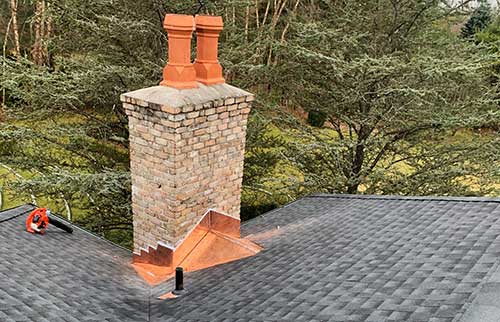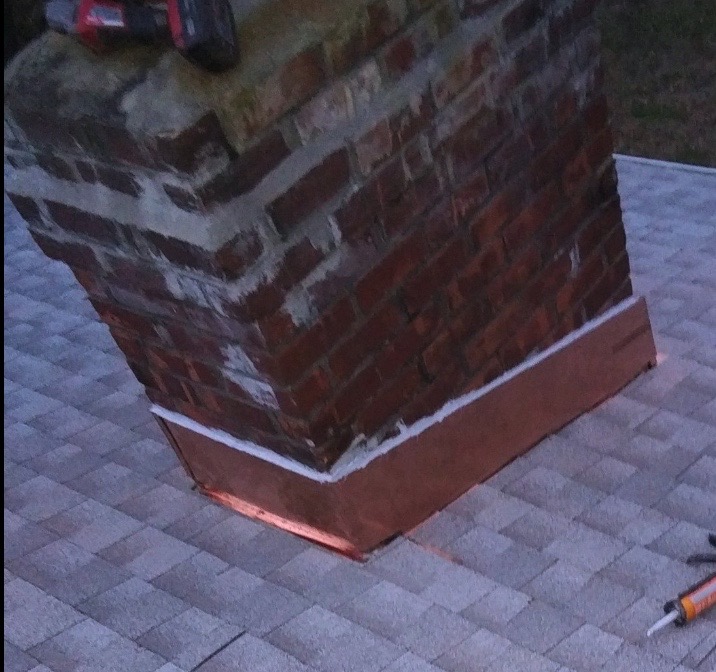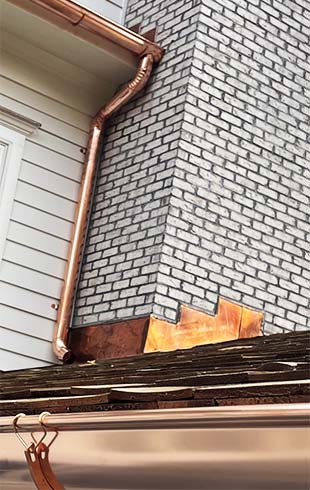Chimney Flashing Repair
Chimney flashing is the metal installed at the intersection of a chimney and a roof line; to prevent water from seeping into the joint. The flashing forms a water-resistant barrier between the chimney and roof, ensuring rainwater and other runoff don’t leak into the home or structure.
My teams are water management experts well versed in roof repair and chimney flashing installation and repair. We work with all the popular flashing materials and can offer Westchester County homeowners full-service chimney flashing repair services and copper flashing specialization.
No matter the flashing material used on your home’s chimney, it must be layered correctly to keep water out and your roof dry.
What is Chimney Flashing?
Chimney Flashing is sheet metal used to seal water out of any openings where the chimney meets the roof. “Chimney Flashing” has one job to keep water out and help divert water away from vulnerable areas.
Various metals can be used in a flashing application, including stainless steel and aluminum; copper is the best metal, known for its longevity, durability, and timeless good looks. The majority of the flashing work we do utilizes copper metal for these and other positive qualities.
Westchester County Flashing Installation
Professional Flashing Installation & Replacement
The team at George’s Seamless Gutters works on Westchester county roofs every day. We understand the critical role of your roof and its related components in protecting your home from the elements.
Chimney flashing can be a problem area on many homes.
When we are called out to investigate the cause of a small roofing leak, the home’s flashing is a common culprit. Chimney flashing has one job: keeping water out and the intersection between the chimney and roofline watertight. When the flashing fails, your roof and everything under it is in danger.
Flashing is worth repairing at the first sign of a breakdown. Damaged flashing opens your home up to a host of threats, including leaks and critters.
Roof Flashing Repair & Replacement: Westchester County, NY
We install and repair all types of chimney flashing, including copper, lead, aluminum, or roofing cement.
In Westchester County, most roof leaks result from poorly installed or damaged flashing. We’re experts in installing flashing correctly, and we only use the best materials.
If you need chimney flashing repair service in Westchester County, we can help. Our chimney and flashing repair experts can take care of all your needs.
Chimney Flashing Replacement and Repair, Westchester NY
Have cracked, damaged, or leaky flashing?
Our expert chimney & flashing technicians are just a phone call away; we offer free inspections and are happy to come out and meet you.
What causes leaks around chimneys?
Here in Westchester, bricks and mortar both pass water and often lots of it. The problem here is usually the freezing and thawing cycle, which happens all winter long and results in damage in the house.
Is your chimney flashing in good shape?
You want to make sure your home is watertight and remains in excellent condition for years to come. You wouldn’t be too pleased if you were to find water leaking in through the chimney, causing damage to the walls, ceilings, and other interior areas. Be sure to look for cracked, curled, or missing flashing around your chimney.
Not sure what to look for? We can come out and perform a free inspection.
Have a roof leak around your chimney?
DO NOT WAIT — Call a roofing contractor right away.
Roof leaks (even small ones) need fast intervention to limit the damage. When considering how to address a flashing leak, the answer is simple; the time is now. There is no time to wait when it comes to leaks.
What materials are used for chimney flashing?
- Aluminum Flashing: This is a popular choice due to its cost-effectiveness and ease of installation. Aluminum is lightweight and can be easily shaped to fit the contours of a chimney and roof. However, it’s more susceptible to corrosion, especially in coastal areas or places with acidic rain.
- Copper Flashing: Known for its durability and long lifespan, copper flashing is a premium option. It is resistant to corrosion and weathers naturally to a greenish patina over time, which can be aesthetically pleasing. Copper is also more expensive but is preferred for high-end installations due to its longevity and performance.
- Lead Flashing: Lead is extremely durable and flexible, making it ideal for complex chimney shapes and sizes. It is also resistant to corrosion and can last for decades. However, due to health concerns associated with lead, its use has declined and it is handled with care during installation.
Each type of flashing has its advantages and is chosen based on factors like the climate, roof material, and budget.
Are there different styles of flashing?
- Yes, there are different styles of flashing used in roofing, particularly around chimneys, to prevent water infiltration. Here are a couple of common styles:
- Step Flashing: This type involves individual pieces of metal that are layered with shingle installation. Each piece of flashing is shaped like an “L” and is installed to overlap the one beneath it, much like steps. This method ensures that water flows away from the chimney and down the roof, rather than seeping into the building.
- Cricket or Saddle Flashing: This style is used when a chimney is wide or is situated on a side of the roof that collects a lot of water. A cricket is a small, peaked structure installed on the uphill side of the chimney to divert water around the chimney, reducing the burden on the flashing system. The cricket itself is covered with roofing material and then integrated with additional flashing to seal the entire area.
Each type of flashing serves a specific purpose and is selected based on the chimney’s size, location, and the roof’s slope and design. These methods enhance the roof’s ability to shed water effectively and protect the home from water damage.













